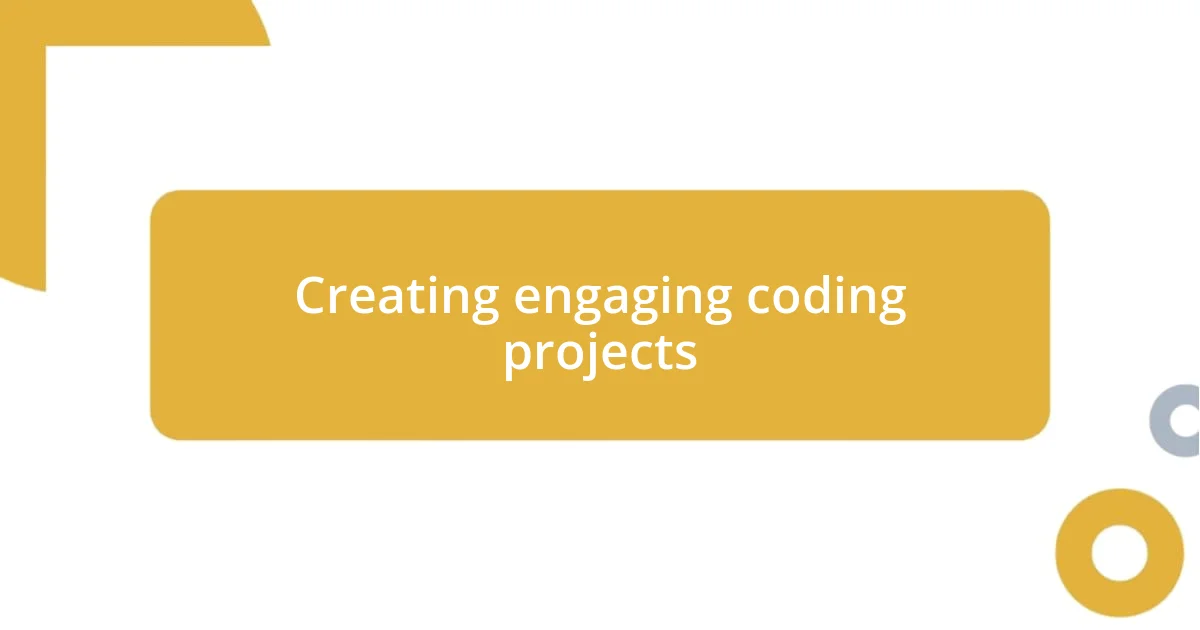Key takeaways:
- Coding encourages problem-solving, creativity, and resilience in children, shaping their mindset and preparing them for life’s challenges.
- Choosing the right coding language, such as Scratch for younger kids or Python for older children, enhances engagement and sustains interest in learning.
- Overcoming challenges in coding fosters a growth mindset, and cultivating a supportive community can transform learning into a collaborative and exciting journey.

Introduction to coding for kids
When I first introduced my child to coding, I was surprised by how quickly they grasped the concepts. It’s like unlocking a new language that allows kids to express themselves creatively while solving problems. Have you ever watched that spark of understanding light up a child’s face when they create their first simple program? It’s a beautiful moment that reminds us just how powerful coding can be.
Coding for kids opens a door to a world rich in creativity and logic. I remember the excitement when my child built their first video game; it was thrilling to see ideas turn into interactive experiences. What struck me the most was how this journey encouraged collaboration—my child began to work with friends, sharing their projects and learning from each other, which sparked a deeper interest in technology.
At its core, coding teaches resilience and critical thinking. There’s a sense of achievement in debugging a piece of code after countless attempts. It got me thinking—how often do kids get to taste that sweet success after overcoming a challenge? This journey of learning coding is not just about the skills they acquire; it shapes their mindset, preparing them for the hurdles they will face throughout life.

Benefits of coding for children
The benefits of coding for children extend far beyond mere technical skills. I’ve noticed that as my child engaged more with coding, their confidence blossomed. For instance, after completing a challenging project, they couldn’t wait to show it off to family and friends. That sense of pride is something I cherish; it’s incredible to witness how mastering a skill can empower a child.
Here are some of the key benefits of learning coding:
- Problem-Solving Skills: Coding teaches kids to break down complex problems into manageable parts.
- Creativity Boost: It encourages children to think outside the box and express their ideas through technology.
- Logic and Structure: Kids learn to think logically, which improves their mathematical skills and reasoning.
- Collaboration and Teamwork: Working on coding projects with peers fosters a sense of community and enhances communication.
- Persistence: Debugging code instills a valuable lesson in perseverance; failure becomes a stepping stone to success.

Choosing the right coding language
Choosing the right coding language can feel like a daunting task, especially with so many options available. From my experience, I’ve found that it usually boils down to the child’s age and interests. For younger kids, block-based coding languages like Scratch can serve as an excellent starting point. I remember my child’s first encounter with Scratch; it was thrilling to see them drag-and-drop code blocks to create playful animations. It brought a smile to their face, making the learning process feel more like play than work.
As children grow and their skills develop, transitioning to text-based programming languages can be a natural next step. Python is often recommended due to its readability and simplicity. I was amazed at how quickly my child picked it up compared to the complexity of other languages. They felt a sense of accomplishment when they successfully wrote their first function, and I saw a newfound determination that inspired me as well. Choosing a language that keeps them engaged is essential for sustained interest.
Lastly, considering what your child aims to create can guide your choice of language. If they’re interested in game development, learning C# will be beneficial since it is widely used with game engines like Unity. I remember attending a discussion where parents shared similar stories, highlighting the excitement of children crafting video games. The right coding language not only paves the way for creativity but also fuels a deeper passion for learning.
| Coding Language | Recommended Age |
|---|---|
| Scratch | 5-10 years |
| Python | 10+ years |
| C# | 12+ years |

Finding coding resources for kids
Finding the right resources for kids to learn coding can sometimes feel overwhelming, but I’ve discovered that several platforms stand out. Websites like Code.org and Tynker have beautifully designed courses that cater to children, making learning both fun and manageable. I remember the first time my child dived into a lesson on Code.org—they were completely absorbed and even asked to continue after dinner! Isn’t it amazing how engaging content can inspire that level of enthusiasm?
In addition to websites, I’ve found that YouTube channels dedicated to coding for kids can be incredibly helpful. Channels like “Kids Can Code” offer tutorials that break down concepts in a relatable way. One evening, we watched an instructional video about creating a simple game, and I could see the lightbulb moment happen when my child understood the concept of loops. It reinforced how much easier it is to learn from someone who speaks directly to them, making it less intimidating.
Don’t overlook local resources either! Many communities offer coding camps and workshops, which can be a fantastic way for kids to learn in a collaborative environment. I recall enrolling my child in a weekend workshop, and they came home buzzing with excitement and new friendships. The social aspect of coding is often just as valuable as the technical skills learned, right? Finding resources that blend learning with play can create lasting memories and foster a love for coding in children.

Creating engaging coding projects
Creating engaging coding projects can truly ignite a child’s passion for technology. One time, my child decided to build a simple game where a character had to dodge falling objects. Watching them brainstorm ideas and sketch out their concept on paper reminded me of my own creative process—how exhilarating it is to see something take shape from mere thoughts! It’s essential to provide a space where kids can freely express their ideas, allowing their imagination to blend with technical skills.
Collaborative projects also offer an exciting dimension to coding. I recall when my child teamed up with friends to develop a mini-website for a school project. The collaboration sparked discussions, debates, and that precious sense of teamwork. It was heartwarming to witness their excitement as they assigned roles based on each other’s strengths. Engaging in teamwork not only enhances coding skills but also builds friendships and promotes confidence.
Incorporating real-world applications into projects can significantly boost motivation. For example, my child once created a weather app, using data they collected themselves. Watching them explore how to fetch and display real-time information added a layer of fascination to the coding process. Do you remember when you first realized your skills could make something practical? That magic of connecting coding with everyday life is what keeps the spark alive, making learning not just a task, but an adventure.

Overcoming challenges in learning
Overcoming challenges in learning coding can sometimes feel like climbing a mountain. I vividly remember a moment when my child was stuck on a particularly tricky coding problem. They grew frustrated, and I could see their motivation waning. I gently suggested taking a break and approaching the issue with fresh eyes, which turned out to be a game changer. When they returned, the solution suddenly seemed clearer, reinforcing an important lesson: sometimes, stepping back can lead to breakthroughs.
I’ve noticed that making mistakes is a natural part of the learning process. One day, my child accidentally deleted hours of hard work—oh, the sheer panic on their face! Instead of despairing, we turned it into a learning opportunity. Together, we discussed the importance of version control and backing up projects—a vital lesson not just in coding, but in life. Have you ever experienced a setback that turned into a teaching moment? Embracing these challenges can foster resilience and a growth mindset.
Finding a supportive community can significantly ease the learning curve. I recall when we joined an online coding group where kids shared their projects and celebrated each other’s successes. It was incredible to witness how encouragement from peers sparked new ideas and provided motivation to tackle difficult concepts. Isn’t it amazing how learning together can transform challenges into shared adventures? This collaborative atmosphere made coding feel less like a solitary pursuit and more like an exciting journey we could all embark on together.

Encouraging ongoing coding development
Encouraging ongoing coding development is all about finding ways to keep the enthusiasm alive. I remember a weekend where my child discovered an online coding competition. They were initially hesitant, feeling it might be too challenging, but after some gentle nudging, they decided to enter. Watching their excitement as they learned something new daily from the competition pushed me to think—how often do we take on challenges that inspire us to grow?
One moment that stood out for me was when my child came home with a coding book filled with advanced concepts. They had been fascinated by the graphics and animations in their favorite games, and suddenly, they wanted to recreate them. This self-driven desire led to countless late-night coding sessions filled with laughter and the occasional frustration. Here’s a thought: have you ever seen someone discover a passion that lights them up? It’s powerful.
Setting small, attainable goals can also play a vital role in keeping the coding flame burning. I encouraged my child to tackle minor tasks—perhaps fixing a bug or adding a new feature—rather than feeling overwhelmed by the bigger picture. Celebrating each achievement, no matter how small, made the process feel rewarding. Isn’t it amazing how recognizing progress can serve as motivation to keep moving forward?











